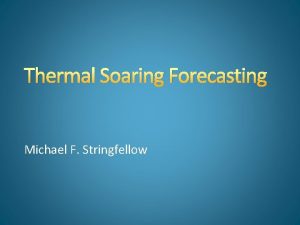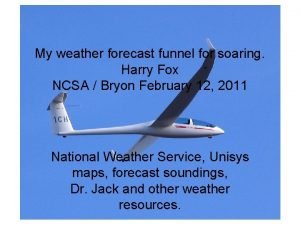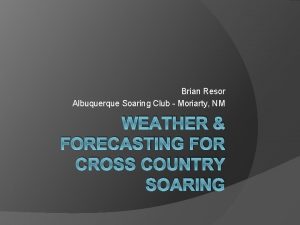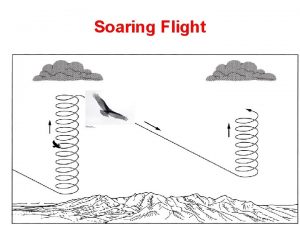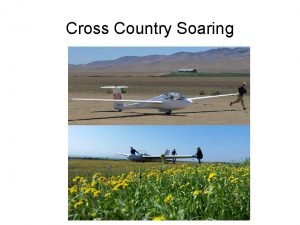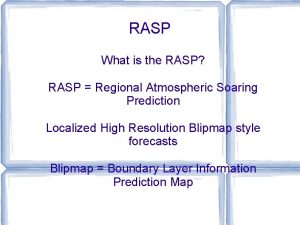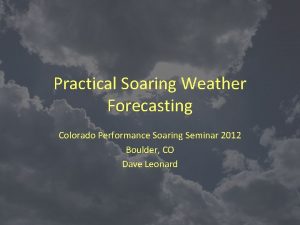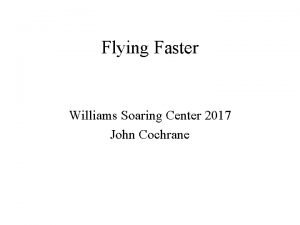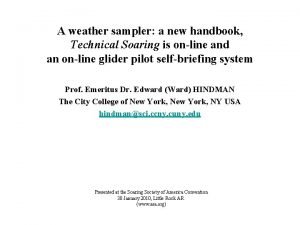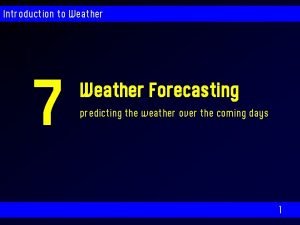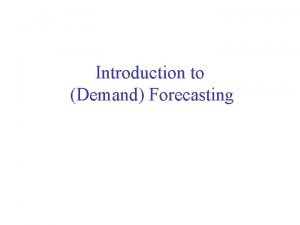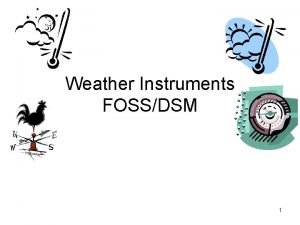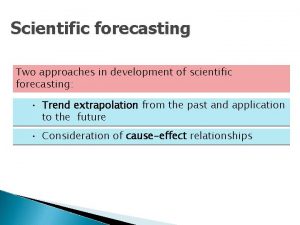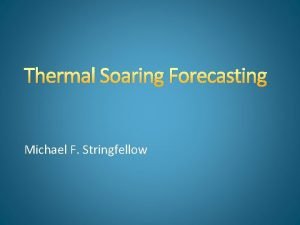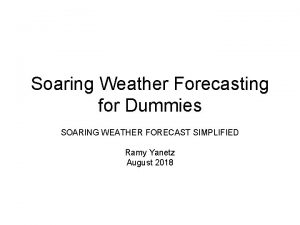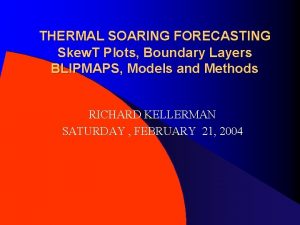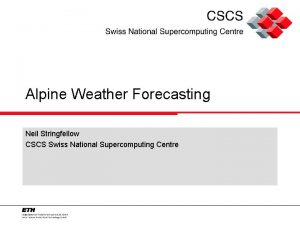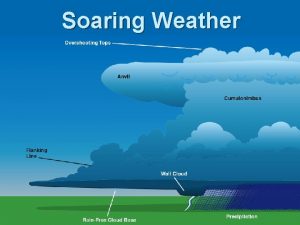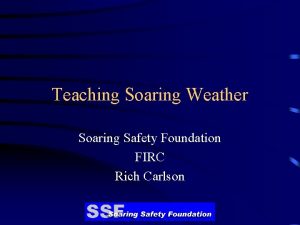Thermal Soaring Forecasting Michael F Stringfellow Introduction n





























- Slides: 29

Thermal Soaring Forecasting Michael F. Stringfellow

Introduction n Thermals n n Columns of warm air that rise from the ground when heated by the sun Soaring n Sustained engineless flight using natural sources of lift

Definitions n Boundary or mixing layer n n Lapse Rate n n Fall of air temperature with altitude Dew Point n n The zone of the atmosphere near the ground where thermals occur Temperature at which moisture vapor in the air condenses Skew-T Chart n Fancy diagram used by meteorologists to plot lapse rate and relative humidity

Making Thermals n Conditions for thermals n Sun heats the ground n n n Pools of warm air can form n n Light winds or shelter Thermal triggers n n Little cloud cover Dry soil Mechanical disturbance (man-made or natural) Hot air near the ground has buoyancy n Air above is lighter (cooler or drier)

Thermal Characteristics n n When triggered, hot air rises If surrounding air is lighter, thermal continues rising Thermal stops when it reaches temperature of surroundings Thermal strength depends on difference of temperature between it and surrounding air n Thermal Index

Thermal Forecasting n Estimate solar heating of ground n n n Cloud cover Time of year/day Estimate lapse rate and dew point of air n n n Actual and forecast soundings Strength of thermals Boundary layer depth (top of thermals)

Forecasting Tools n n National Weather Service NOAA Dr. Jack’s Blipmaps Soaring forecasts

Forecasts from Soundings -3 TI at 7, 500 feet

How I Forecast Thermals n Check actual and forecast weather n n Check satellite maps n n Visible, Infrared and water vapor Check Blipmaps n n Weather Service, Webcams Thermal strength, top-of-the lift, buoyancy/shear ratio, cumulus prediction Check Forecast Soundings n Temperature, winds lapse rate, inversions, cloudbase, convective potential etc.

Soaring Forecast Page n Seven main sub pages forecasting: n n n n Current Weather Forecast Weather Blipmaps & Blipspots Mike the Strike’s Forecast Week’s Soaring Forecast Weather Links Webcams

Reading Blipmaps - 1 n Thermal Strength n n n Predicted average net thermal strength Subtract glider minimum sink rate to estimate actual rate of climb Remember thermals will vary from weak to strong

Reading Blipmaps - 2 n Top of the lift n n Hcrit is top of the lift experienced by a glider in feet MSL Usually at the – 3 TI point on the Skew-T chart

Reading Blipmaps - 3 n Boundary Layer Depth n n Height of thermals above the ground in feet Remember you won’t usually get this high in a glider

Reading Blipmaps - 4 n Cumulus Potential n Chance of thermalgenerated cumulus clouds

Reading Blipmaps - 5 n Overdevelopment Potential n n Chance for showers and thunderstorms Usually not good when too high!

Reading Blipmaps - 6 n Buoyancy/Shear Ratio n n Indicates chance of thermals blowing apart in wind Less likely with strong thermals or weak winds >5 is usually OK <5 thermals broken

Reading Blipspots Data for 2 PM Local

Reading Skew-T Charts Predicted Dew Point Temperature Atmospheric Pressure Wind Speed & Direction Predicted Air Temperature

Interactive Skew-T (Arizona) Convective Potential Energy Predicted Cloud Base Boundary Layer Top Predicted Parcel Motion

Interactive Skew-T (Arizona) Stable Air Top of the Lift (5, 600 ft)

Interactive Skew-T (Florida) Top of Lift (28, 000 feet) Unstable Air

NOAA’s Ready Forecast Tools

NOAA Ready Menu

READY RUC Sounding Menu

READY RUC Sounding Result

Ready Interactive Map Menu

Resulting Map of Arizona

Boundary Layer Height 7845 Ft 2450 meters

Summary n Check forecast weather n n n Sun Cloud Winds Maximum temperature Satellite images Check Blipmaps & Blipspots n n Thermal strength Top of Lift Cumulus Buoyancy/Shear n Check Soundings n n n Check Trends n n n FSL Interactive NOAA Ready High pressure building? Dry air moving in? Watch the sky n n Do conditions match the forecast? Check temperatures
 Paris stringfellow
Paris stringfellow Section 3 using thermal energy worksheet answer key
Section 3 using thermal energy worksheet answer key Thermal transfer vs direct thermal printing
Thermal transfer vs direct thermal printing Rasp soaring forecast
Rasp soaring forecast Reno soaring forecast
Reno soaring forecast Moriarty nm weather
Moriarty nm weather Soaring eagle nursery
Soaring eagle nursery Condor wings
Condor wings Cross country soaring
Cross country soaring Caesar creek soaring club
Caesar creek soaring club Ridge soaring gliderport
Ridge soaring gliderport Blipmaps
Blipmaps Boulder soaring forecast
Boulder soaring forecast Williams soaring center
Williams soaring center Technical soaring
Technical soaring Colvestone primary school
Colvestone primary school Soaring safety foundation
Soaring safety foundation Soaring safety foundation
Soaring safety foundation Hierarchical production planning
Hierarchical production planning Introduction to weather forecasting
Introduction to weather forecasting Demand forecasting introduction
Demand forecasting introduction Thermal power plant introduction
Thermal power plant introduction Significance of human resource planning
Significance of human resource planning Weather instruments
Weather instruments Color forecasting definition
Color forecasting definition Hotel demand forecasting
Hotel demand forecasting Technology life cycle
Technology life cycle Strategic forecasting inc
Strategic forecasting inc Strategic assessment in spm
Strategic assessment in spm What are the two types of forecasting
What are the two types of forecasting



